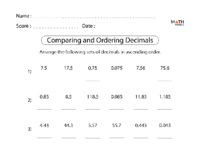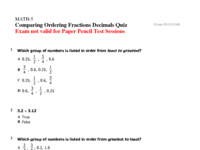Fractions and Decimals
Lesson Objective:
Student-Facing Learning Target:
Vocabulary:
Part One: Comparing Fractions and Decimals
Exercise 1:
Use <, >, or = to compare the following
1. 0.8 ___________ 0.45
2. 4/6 _____________ 2/3
3. 1/2 ______________ 0.75
Part Two: Fraction Word Problems
1. Kim rode her bike for one-fifth of a mile on Monday and two-fifths of a mile on Tuesday. a.)How many miles did she ride altogether?
b.)On Wednesday, she rode on half of a mile. If she does that every day for 4 day, how far did she ride her bike?
2. Jake needs to walk 7/10 kilometers to school. He has already walked 3/10 kilometer. a.) How much further does Jake need to walk?
b.) After school, Jake had to stop by the bookstore. The bookstore is one-fifth of a kilometer from school. What is the total distance Jake will walk after going to school and then the bookstore?
3. There was 5/8 of a pie left in the fridge. Daniel at 1/4 of the leftover pie. How much pie is left over?
Part Three: Decimals Word Problems
1. Brenda and Jenna together saved $12.75 last week and $8 this week to buy a gift for Mother's Day/ a.) The gift they want to buy costs $17.50. Do the sisters have enough money for the gift?
b.) If the sisters want to split the cost of the gift, how much should each pay?
c.) Brenda also wants to buy 5 chocolate bars for their mom. Each chocolate bar cost $0.95. How much total money does she need for the chocolate?
2. Becca is biking across the country over her summer break. a.) She biked 47.5 miles everyday Monday through Friday. How far did she bike?
b.) She biked 12 miles on Saturday and 9 miles on Sunday. What is the total distance Becca biked this whole week?

